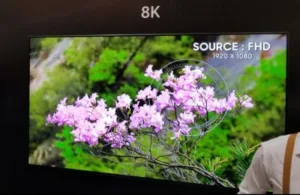Samsung generated plenty of pre-IFA news when the media started reporting on the 8K TV banners hanging around the IFA fairgrounds. The company did not disappoint, revealing its plans to roll out 8K TV as soon as October (we actually saw one being shown in a retail shop in Berlin, too).
To kick off its IFA presence, Samsung held a well-attended (over 900 people) press conference. President and CEO of Samsung Electronics HS Kim took the stage to deliver some high-level messages about Samsung and industry trends with their key theme being, “Do What You Can’t.”
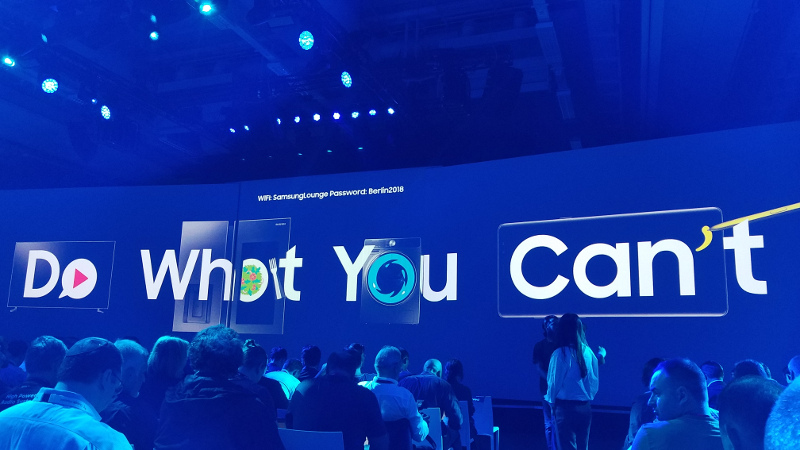
Kim said that the company is very much focused on connecting all of their devices to “make people’s lives better.” They have already committed to making all devices IoT capable by 2020, with AI technology forming the backbone of future benefits of this connectivity.
Last year, Samsung spent $14B on R&D. For the next three years, it has committed to spending $22B to further develop AI and 5G hardware, software and services via a number of new global R&D centers. Kim was clear in saying they want to develop solutions that are “always learning, always safe and always helpful. People should not fear AI will take over our lives,” said Kim. Bixby will be their scalable AI platform.

Guy Kinnell, VP for Visual Displays then took the stage to discuss some of the company’s product range. He started by citing some market data that indicates that 1.9M TV of 75” and above will sell in 2018, but will increase to 5.1M by 2022. This will be a key focus area for Samsung. This increase will mirror the adoption of 4K TVs in the 55” category. In 2013, 55” and larger 4K TV were 3% of sales, but they are at 70% now.
Kinnell then introduced the new 8K QLED TV noting these will be offered in four screen sizes: 65”, 75”, 82” and 85” (the availability of 82″ in Europe is not yet certain, I heard – Man. Ed.). Apparently, only the 85” will be offered in the US, however. Specs include a whopping 4000 cd/m² (probably specified in dynamic mode with a 10% window for 5-30 seconds) and 100% DCI-P3 color volume via film-based quantum dots. These will be full array backlights although the number of zones was not specified. HDR10, HLG and HDR10+ will be supported but not Dolby Vision.
Kinnell also highlighted Samsung’s new AI-based upscaling engine that does a very good job of upscaling FHD and 4K content to 8K and can even improve SD content as well. AI is also used to improve the sound adjustment dialog so it is always clear on a scene-by-scene basis. The TVs will be offered with a new soundbar as well that supports DTS-X and Dolby Atmos.
The Wall was then described as an offering with “perfect black” that has a low reflection surface and wide color gamut. It is HDR10+ capable and is available now in Europe for custom ordering, although no pricing has been discussed publicly. (I heard ‘between €300,000 and €400,000 – Man. Ed.)
Kinnell said that the company’s Frame TV has been quite successful as well with over 850 pieces of art and photography now available to display on the TV when not actively watching it. New for Europe is a 49” model.
Dan Harvie then described some of the products in appliances, which we will skip.
Innovation Room
Samsung had a private meeting room where it was doing demos, mostly for the media. One of the key messages was on the upscaling the new 8K TVs can do for 4K as well as 2K content. The demo consisted of a 70” Sharp Generation 1 8K monitor side-by-side with an 85” Samsung 8K TV (Q900R). The same content was shown on both with noticeably better sharpness, color and contrast on the Samsung set. Both were in their “out-of-box” settings, but basic contrast, color performance and brightness of the Sharp set was not great. To be fair, it did not look that much better in the Sharp booth (although their Gen 2 displays did look a lot better). Both 2K SDR and 4K HDR content was shown to demonstrate the upscaling fidelity (more on this below).
Samsung representatives talked about the benefits of 8K and the evolving state of the ecosystem, but admitted that native 8K content will be rare outside of Japan in the near future (NHK starts regular 8K broadcasting there in December). Therefore, upscaling will be a critical component of an 8K TV – which is why they were highlighting their expertise in this area.
The heart of the processing uses an Artificial Intelligence (AI) engine based upon machine learning, which are algorithms with the ability to learn without being explicitly programmed. AI and machine learning techniques can be applied to many fields but for TVs, Samsung uses the technology for super-resolution or up-scaling processing.
Machine learning requires the evaluation of millions of samples – low resolution and high resolution images in the case of up-scaling. By comparing low and high resolution images of the same objects, the differences can be coded as “learning kernel coefficients”.
The data of learning kernel coefficients for audio files and still images are quite small and can be supported as cloud-based processing. But video is far more complex with much bigger data sets. This makes cloud-based processing too risky, so Samsung embeds these coefficients in the TV image processor for local and fast access in the upscaling process. These coefficients also include tone mapping instructions to modify the PQ curve for that particular object.
Comparing images may sound simple but building the database of objects and these kernels is an enormous investment that Samsung is now leveraging for their 8K TVs. This can done by starting with high quality images and creating degraded versions – ideally simulating the type of low-quality images a typical consumer can expect to receive into their home. This means degrading the resolution, adding noise, blurriness, and compression/decompression cycles at various levels to induce artifacts. Sometimes both and low and high resolution pairs are available as well.
All of these samples are analyzed to classify the type of objects they are and to develop the methods that best restore low resolution images to higher fidelity. This is all done by machine, not humans, as it would be impossible to process the millions of images needed to develop these algorithms.
The result is a “formula” or algorithm that is assigned to each class of image and based upon the resolution of the incoming image as well (i.e. SD, HD, FHD or UHD). These formulas or Kernels are then assembled into a data bank which is embedded in the TV.
Inside Samsung’s new 8K TVs is an upgraded Q Engine dubbed the Quantum 8K Processor. It is what is responsible for applying these formulas to video content to create 8K images for display. The 8K AI upscaling engine focuses on improving four picture quality elements: detail creation, edge restoration (reducing blurring via interpolation), noise reduction (focused in particular on improving the quantization noise you get with compressed streaming sources) and the removal of jaggedness from curved and angled edges.
The private demos showed examples of each of these enhancements. Samsung then comparted the same 4K image shown on a 4K TV and then on the 85” 8K TVs. Improvements were clearly noticeable (no photos were allowed in these media sessions).
On the Show Floor
Samsung was clearly highlighting its 8K TVs as a main focus on the show floor. The new range is dubbed Q900FN and will be offered in 65”, 75”, 82” and 85”. The 85” 8K TV may reach 4K cd/m² in a dynamic mode in a 10% window for 30 seconds. It will be lower, perhaps around 3K cd/m², when in a more reference-type movie mode, however. The other screen sizes may not reach this level, we are not sure yet. It is a QLED model so will cover the full DCI-P3 color space as well. HDR10, HDR10+ and HLG support will be built in. They will not have an HDMI 2.1 interface however, which can support input signals at 8K/60p. Only 8K/30p signals can be accepted on these sets over HDMI, but we believe the panel will refresh at 60 fps. No firmware update can fix that limitation. All will have direct backlights with various levels of zones for local dimming (numbers not specified).
The first sets should go on sale by the end of September or early October. We even saw one in a shop (Saturn) that was being demonstrated but not for sale yet, so it is imminent.
The chart below summarizes all the benefits Samsung sees for its 8K TVs.
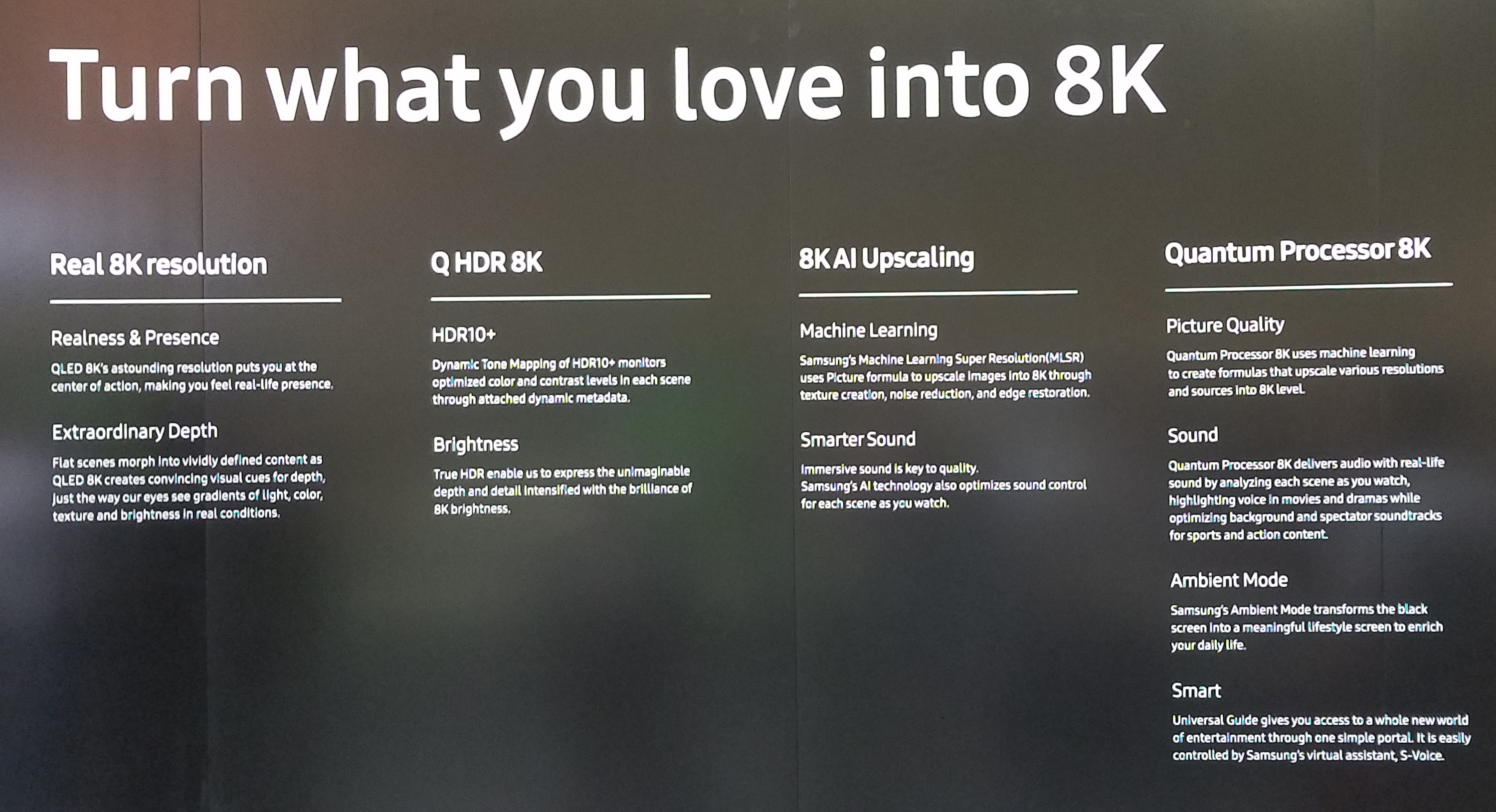
There was a very nice demo of upscaling on the show floor as well. Here, attendees could choose the resolution of the source content and see how it displayed on a Samsung 4K TV and on the 8K TV. Viewers could choose content at UHD (3840×2160), FHD (1920×1080) or even SD (720×480) resolution. Clearly, the UHD content looked the best with circles also provided to help the viewer focus on the areas of most improvement. This was mainly more details in finely detailed structures and more sparkle in specular objects. FHD scaled nicely too with clear improvements in crispness, colors and contrast. Even SD content showed some improvement in the reduction of compression noise and jaggies. I took photos but the differences were not really captured.
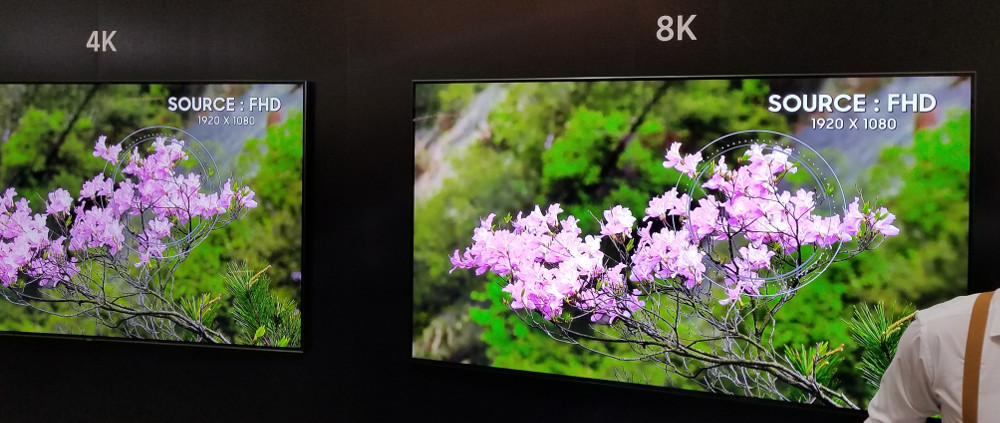
We next took a long look at The Wall, which is now taking orders on the B2B side, but not on the B2C side, we understand. No pricing has been revealed. Th set up consisted of the 146” wall display flanked on either side by more conventional LED signage display (maybe 2mm pitch). The Wall has a 0.85 mm pixel pitch. There was a rope in front of the screen limiting how close you could get, about 8 feet (2.4m) by my estimation. At that distance, no pixels could be discerned. The display was covered with a top surface to limit ambient light and once inside, it appeared to be quite bright (no spec on level). Colors looked very vibrant and quite saturated but we did see some what looked like compression artifacts (blockiness) in some of the darker tones. Not sure if that was in the content of a display/decoder issue.
Various piece of content were shown (mostly slowly moving images) that were designed to highlight the applications where the Wall can be used. These were: Corporate lobbies (landscapes), museums (artwork), retail (yarn and fabrics), hotels (tourist sites), and entertainment (fish). There was no spokesperson to add any additional information.
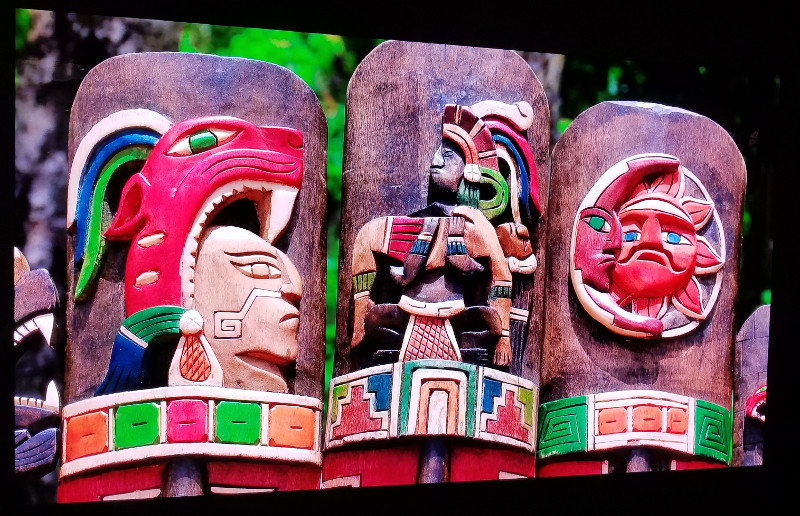
(I took the photo below which shows a very visible seam between the tiled panels used for the Wall display. I commented that I wouldn’t be very happy if I had spent hundreds of thousands of € on this kind of TV to see this kind of problem, but staff told us that some artefacts are ‘inevitable’ – Man. Ed.).
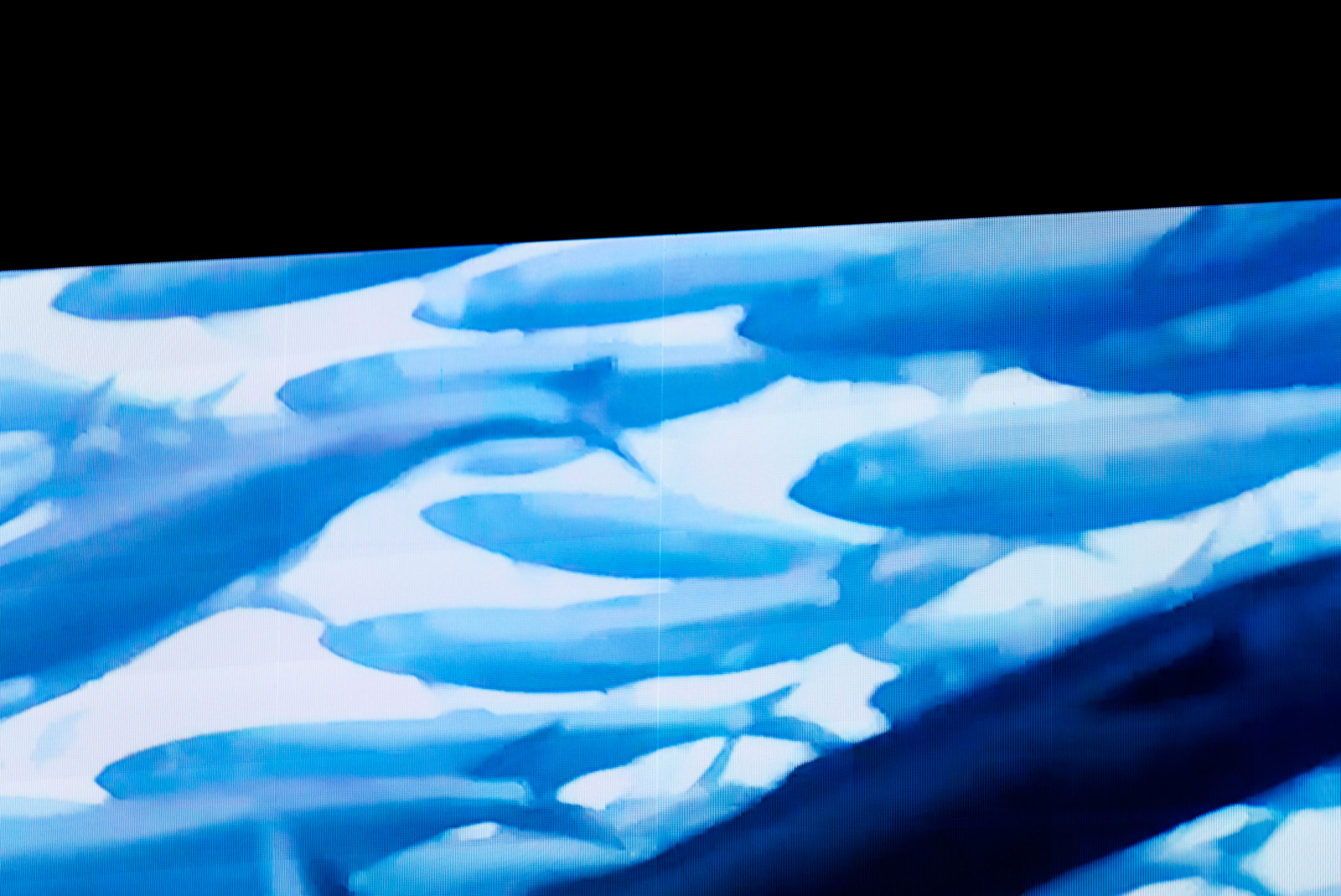 The bright line on ‘The Wall’ was clearly visible in some scenes, but not in others. Image:Meko Click for higher resolution
The bright line on ‘The Wall’ was clearly visible in some scenes, but not in others. Image:Meko Click for higher resolution
We also walked around the large Samsung booth in City Cube where we saw stations highlighting the Frame TV product (no news here but the claim to now have the world’s largest art collection on TV) and the Ambient mode on the Q9 4K TVs. At IFA, Samsung was gathering feedback on what type of content to add to the library for display in ambient mode. Examples were wallpaper designs or color schemes to match the wall the TV is mounted on, artwork, info like weather or news, or novel graphical elements (photo below).
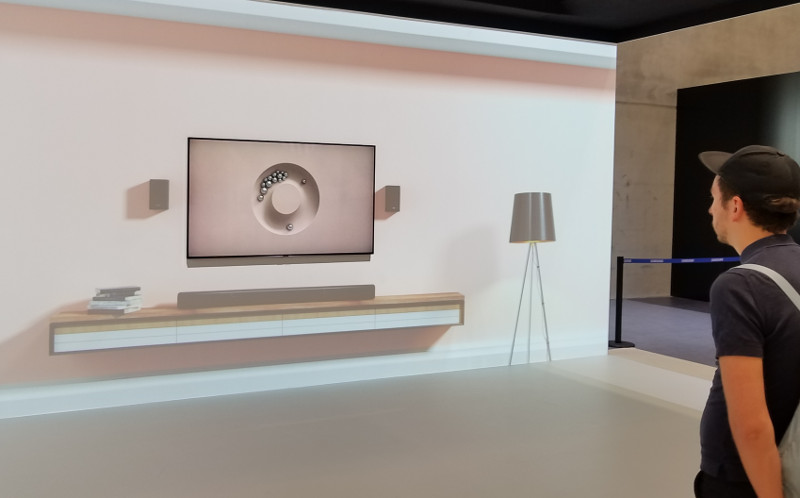
The company also had a fun demo that said “75” is not that big”. The way they showed this was to demo a 60” PDP from around 2008 with a big border, which was removed to reveal a 75” with the same footprint, but now all image. – CC
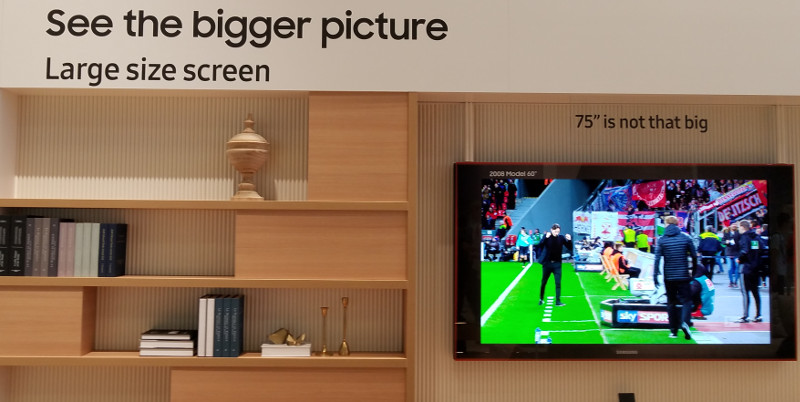
Monitors on the Booth
There was an area devoted to monitors on the booth and it was arranged mainly around gaming monitors. At Infocomm, we reported that Samsung would have a 43″ of its curved CJ89 monitor in the future and it was shown at IFA. It has an 1800R curved VA panel with 3840 x 1200 resolution (32:10) with 3,000:1 contrast and 300 cd/m² of output and 120Hz refresh. There are dual USB Type-C ports and the unit has an integrated KVM to allow the use of dual computer systems with a single display. (Samsung To Double Down on LED)
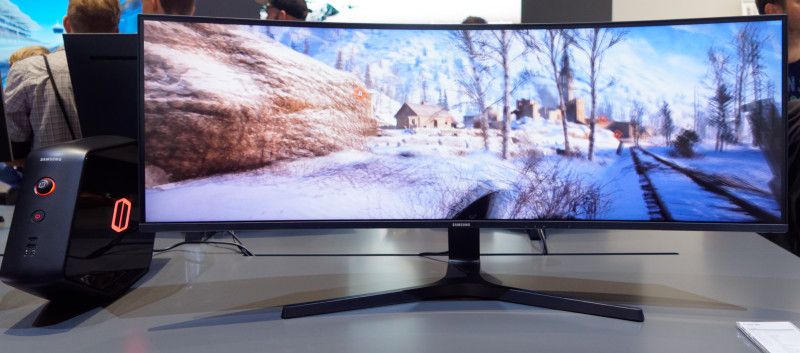 The CJ89 is now available in 43″ as well as 49″. Image:Meko
The CJ89 is now available in 43″ as well as 49″. Image:Meko
The company also showed the UH75 and UH85 28″ and 32″ UltraHD monitors as well as the CJ791 and CHG90 curved monitors which were announced at the beginning of the year.
There was less emphasis on commercial large format displays than there has been in the past at IFA, but several small pitch LED walls were used.
Mobile is all around Note 9
The main focus of the mobile area of the Samsung booth was the recently announced Note 9. This was our first chance to look at the phone and it is very impressive, although it is not revolutionary. The AMOLED 6.4″ display looks very good. Samsung was trying to encourage people to try the pen and we were slightly surprised (given how bad our handwriting is!) that the system recognised a couple of hand-written notes, although the method of conversion from graphics to text was a little cumbersome. Although Samsung has highlighted the Dex features that allow the use of the Note 9 as a desktop system, but at the show, we didn’t spot any special demonstrations.
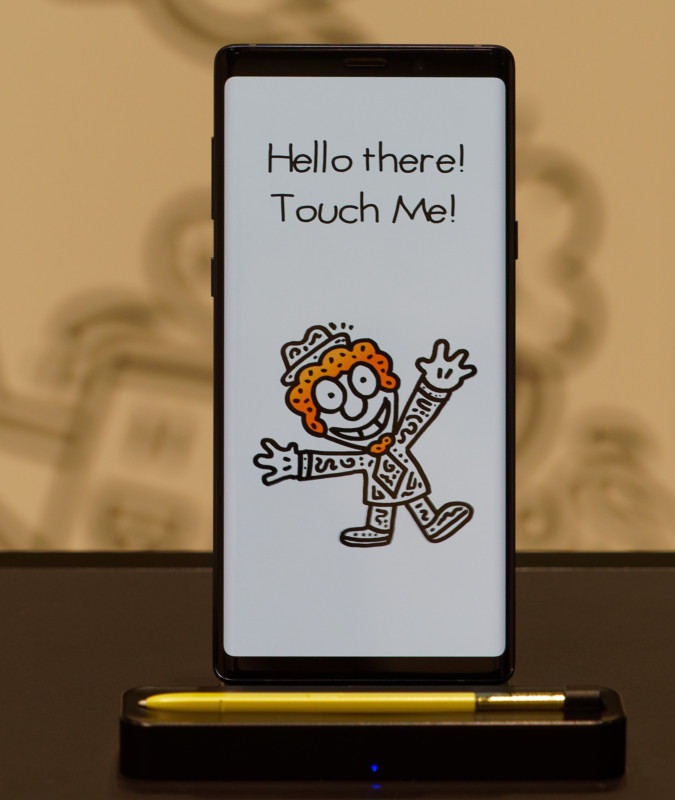 Samsung was emphasising the pen features of the Note 9. Image:Meko
Samsung was emphasising the pen features of the Note 9. Image:Meko
Of course, Samsung had a large area devoted to appliances, but we didn’t spend any time there.

